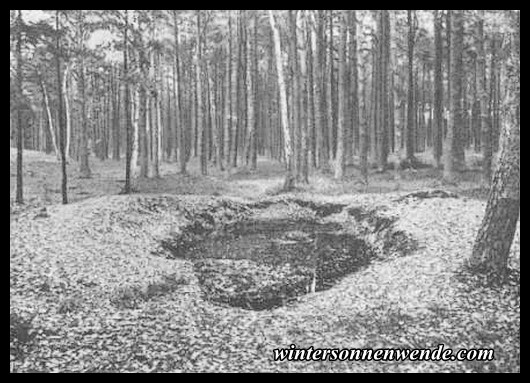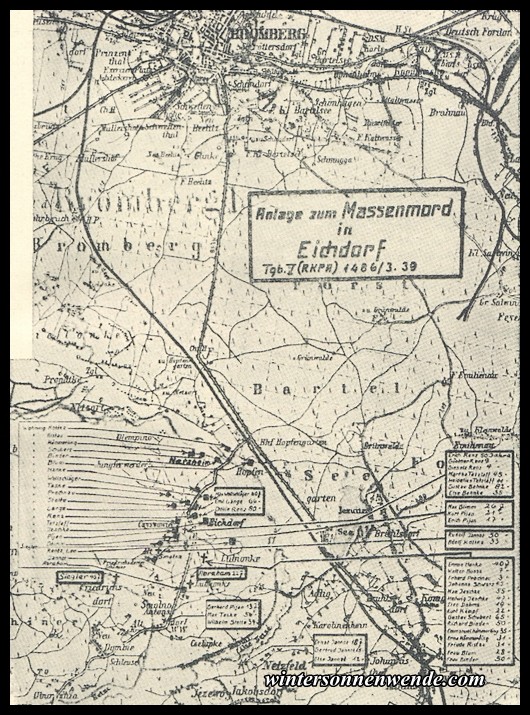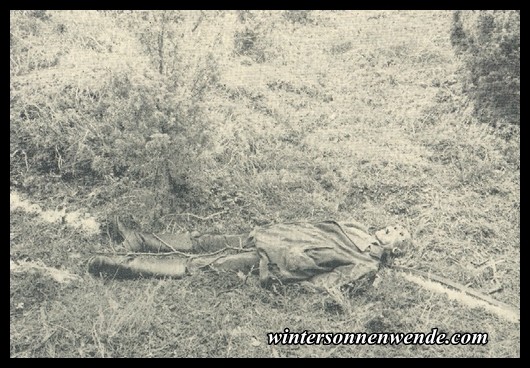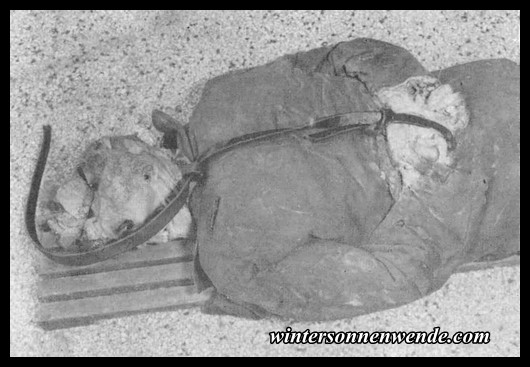 |
Documents: Cases of Typical Atrocities, Part 4
[81] 42. The Massacres of Eichdorf
42. The Massacres of Eichdorf38 Victims of Polish "Civilization" – Minority Germans aged from 3 to 82 years shot indiscriminately
Extract from the records of the Reich Police [Headquarters] – Special Commission in Bromberg – Ref. No. Tgb. V (RKPA) 1486/3.39.
I.
From the late evening of September 4, 1939 until the evening of September 5, 1939, 38 minority Germans, from infants of 3 years up to old people of 82 years, belonging to the parishes of Eichdorf and Netzheim on the road from Bromberg to Labischin, were murdered by members of a Polish infantry regiment, whose regimental number has been ascertained.
Eichdorf, in the neighbourhood of the smaller parish of Netzheim, is a settlement established by German peasants centuries ago, which contained until 1918 not a single resident of Polish race. As a result of the fact that, up to the time of the Polish war, the population was 80 per cent German, there was, even on the "Bromberg Blood Sunday," comparatively speaking, a peaceful atmosphere in the parish, particularly as no Polish military unit occupied the immediately surrounding area until that date.
Late in the evening of September 4, 1939, Polish soldiers, pouring back along the road from Bromberg to Hohensalza, entered Eichdorf and Netzheim. These troops occupied provisional positions, and shortly afterwards, with the murder of the farmer Emil Lange of Eichdorf, began an orgy of murder probably unparalleled in the history of all civilised nations.
II.
Unimpeachable discoveries made at the various places of murder show quite clearly the positions in which the murderers and their victims were standing when the crimes were committed, whilst spent cartridges found lying about corresponded in some cases with shots lodged in the bodies of the dead men, and a handkerchief stamped by the Polish military authorities revealed the battalion involved. Also parts of letters and cards, the senders of which were Polish
soldiers. – All these facts help to substantiate the following:On the road which branches off at Hopfengarten Station from the Bromberg–Hohensalza road and leads to Gnesen, over Labischin, lie a few houses of Hopfengarten and those of Netzheim and Eichdorf, all more or less together on a strip of land just 2 miles long, so that there is hardly any noticeable interstice between each of the three parishes. Among these houses were 21 houses of German families, who, with 38 murder victims on one single day, have been almost completely wiped out.
In this particular case, Polish "civilisation" was demonstrated by 38 victims in eight different spots, of which six are
On the advice of the Polish village-elder, the Janot children, together with their mother, attempted to escape in the early morning of September 5, 1939, two days after their father had gone into hiding in the fields. Frau Janot, however, was stopped by Polish soldiers and forced to return to her farm, where she was to hand over the horses and waggon of the family to them. On the advice of the mother, the children were to await her return, but through some unknown agency were caused or compelled to go on alone. They chose the way through the wood south-east of Eichdorf, which would lead them, on the other side of this wood, over a stretch of meadow, bog, and pasture-land, 1½ miles wide and completely open, to Netzfeld, where their grandmother lived. Unimpeachable witnesses, residents of Netzfeld, who were lying hidden in the willow bushes on the outskirts of the village, state that the children, on leaving the open ground, were simply shot down by military sentinels who were in hiding at the entrance to Netzfeld. And this the sentinels did after a short debate and – as is revealed by the discovery on the spot of pieces of the birth certificates of the children – after examining the papers of the children. Shocking even for experienced police officials hardened against sentimentality by constant investigation into daily capital crimes, was the examination of two particular spots – two of five such places all lying close to one another – where 80 year old Ottilie Renz and her two grandchildren, Gisela and Günther, aged four and nine, were murdered. And equally shocking to examine another place where the Poles massacred 15 minority Germans, among them 8 women, a seven year old child and a 3 year old child.
The house of the Leo Renz family lay some distance from the road, and for this reason Erich Renz, the brother, whose farm was near the road, sent his two small children and his aged mother to Leo, whilst he himself, together with his wife, remained on his own property. But on the morning of September 5, 1939, Polish troop formations appeared at Leo Renz's farm. Little Gisela and Günther
Renz – made afraid by the anti-German agitation of the past weeks, which had frightened even the children of the
village – made use of the first confusion and escaped through a gate at the back of the farmyard into the wood. A short time later, the Leo Renz family were ordered also to leave their home, without being able to take with them the old woman, of whom they then lost sight. A few days afterwards, members of the family found a grave in the wood, 50 yards distant from the road. From this grave stuck out a child's head and hand. It was the grave of Gisela and Günther Renz and their father, hurriedly buried. Inquiries revealed that Erich Renz must have seen the danger of his children from his
hiding-place in the fields, and in attempting to help them had been murdered together with his little son and daughter. The old woman, Ottilie Renz, was found hurriedly buried near the wall of her son Erich's house, underneath a large potato box. How the old woman went from Leo's house to Erich's can only be surmised, but the
Thrown into a cattle-trough together with the body of a dog Of a quite different nature were the discoveries made at a place in the woods near Targowisko, about 300 yards from the high-road at Eichdorf. Soldiers, directed by officers, had led 46 Germans, aged from six months to 80 years and of both sexes, to a small slope in the wood, forced 15 of them to run up the slope and shot these 15 down after they reached the top. The names of the 15 shot in this manner were:
The distance from the place where the group of Germans stood herded together, to the top of the slope was a little less than 20 yards, and to the place where the victims fell, between 30 and 36 yards. If one may mention special cases in a deed so uniformly horrible, then one must mention the lame children's nurse Johanna Schwarz, who had to run up the slope together with her little charge Erhard Prochnau, and Frau Hanke who ran with her
[86] Examination of the other places in this group yielded discoveries which, although in each case different in themselves, are yet not sufficiently different from those described in the foregoing paragraph to merit a full description. It would mean merely considerable repetition to go fully into murder-cases of Martha Tetzlaff, 45 years old, Heidelies Tetzlaff, 11 years old, Else Behnke, 35 years old, Gustav Behnke, 82 years old (all members of one family), or into any of the other cases.
III.
Even in the form of extracts from extensive records, the descriptions given make it impossible to doubt for a moment that the Polish soldiers not only committed the murders on the commands and before the eyes of their officers, but also gave expression to their loathing for everything German, in every conceivable way. Apart from the fact, ascertained by
medico-legal experts at the post-mortem examinations of the victims, that shots were fired from military rifles and highly effective firearms, from all ranges and from all sides and angles, and at children carried in their mothers' arms, and that the Germans were stabbed and slashed with the
bayonet – apart from all this, the treatment of the bodies merits special mention. The brother and sister Janot were simply left lying in the place where they had been murdered, so that animals had already begun to feed on the bodies before the relatives, after the departure of the troops, were able to bury them. The bodies of the Tetzlaff family lay in a disorderly heap, covered with a layer of earth about 8 inches deep, whilst parts of the bodies of the murdered Renz children actually protruded from the earth and, in this way, were discovered by the searching mother. Typical is the case of the murders in the Targowisko wood, where the 15 murdered men, women and children were thrown, together with the body of a dog, into a
cattle-trough.
IV.
The foregoing report indicates clearly in how great a measure this systematic murdering by the Polish military wiped out the German population of the country, as for instance that of Eichdorf.
Of the 130 Germans of Eichdorf, up to September 3, 1939, eleven had fled, five had been called up for Polish military service, and five others called up for other service by the Polish authorities. Thus, on September 3, 1939, i.e. before the appearance of the Polish soldiers, the German population of Eichdorf was still 109 persons. Of these, in the night of September 4, 1939, and during September 5, 1939, thirty persons1 were murdered, that is 19% of the whole population, 23% of the German population as it was before the outbreak of war, and 27.5% of the persons belonging to the German minority who were still in Eichdorf at the beginning of the war. The thirty victims are distributed among 15 of the 30 German families of Eichdorf, that is to say that 50% of the German families were bereaved, some in so terrible a manner that, as in the case of the Jeschke family, there was not one With reference to sex and age, the thirty dead of Eichdorf can be classified as follows:
There were 15 men murdered, that is 50% of the total of the dead, of which 46.6% were over 50 years old, 20% over 60 years and 2 only 17 and 18 years old. Of the others, there were 8 women, i.e. 26.6% of the dead, aged 15 to 80 years, and 7 children from 3 to 13 years
old – so that 23.4% of the total number of those murdered consisted of children under 14 years.   43. Legs and hands broken, tongue, nose and ears cut off
43. Legs and hands broken, tongue, nose and ears cut offMassacre in Schrimm The witness Adolf Ertl, merchant in Czempin, District of Kosten, deposed on oath as follows:
... Nine of these comrades were attacked, in Schrimm, by the populace and so maltreated in the open street that they died. My comrade Willi Mantei had the entire base of his skull smashed, Herbert Raabe had his eyes gouged out and his fingers cut off. Others also lost fingers, in some cases legs and hands were broken or dislocated. Still others had their faces completely mutilated by blows, their tongues, noses and ears cut off. Source: WR II
  44. The arteries severed
44. The arteries severedDiscovery of hideously mutilated corpses in Schrimm The witness Oskar Hartmann, brick-works manager, of Schrimm, deposed on oath as follows:
... In one grave there was a person who could not be identified. Further, in the Protestant graveyard of Schrimm, the bodies of the following persons were found: Conrad Lange, Wilhelm Schulz, Heinrich Häussler, Wilhelm John, Erich Gaumer, Richard Weibt, Wilhelm Jeschke. All the bodies were more or less mutilated. The heads were knocked in, tongues, noses and ears cut away. Hermann Raabe had had his eyes gouged out. There were arteries severed and the
shin-bone of one body was completely smashed. Source: WR II
  45. Father, husband and uncle murdered
45. Father, husband and uncle murderedThe witness Gertrud Lemke, of Hohensalza, deposed on oath as follows: My name is Gertrud Lemke, nee Kadolowski, born on April 8, 1906 in Elbing, married since 1937 to Herbert Lemke, compositor, of Hohensalza. Re. matter: On Wednesday, September 6, 1939, at about 11.30, a member of the Polish Army in uniform, and carrying a carbine, and eight or ten civilians with bludgeons entered our home. The soldier ordered my husband to go with him at once. As my husband had forgotten his passport, I ran after him a few minutes later, but was only in time to see him, accompanied by my father, the soldier, and the civilians, turn the next corner. I heard no more about the fate of my father, husband, and uncle until Sunday, September 10, 1939, when my father-in-law came to me and related that eight bodies, partially burnt, had been found in the neighbourhood of our flaying-house. The bodies had lain on the ground and dogs had already been at them. I begged him to go himself and find out whether our relatives were among the dead. When my husband and father were taken away, I had already a feeling that I should never see them again, as for some time there had already been intensive agitation against Germans in Hohensalza.
A short time later, my father-in-law came back and confirmed my fears. Between two
straw-ricks lay my husband, my father, my uncle, three men of the Fuchs family and an assistant of Herr Fuchs. The eighth victim was unknown.... Source: WR II
  46. Twenty-seven murdered Germans in the churchyard of Kaminieck
46. Twenty-seven murdered Germans in the churchyard of KaminieckHurriedly buried in a hole – Soles of feet cut away The witness, Maria Richert, nee Richert, farmer's widow, of Rybno, deposed on oath as follows:
... On Tuesday, September 12, 1939, or Wednesday, September 13, we found my son and the farmers Gatzke, Dreger and Tober in a small wood near Koneck, hurriedly buried in a hole. They had gouged out one of my son's eyes, his back showed numerous bayonet wounds and on both arms were deep cuts, so that the flesh hung down. The whole of the left side of his face was also missing. Dreger's stomach was hanging out of his left side, whilst the soles of Tober's feet had been cut away and blood ran from his back. We found the Konrad brothers in a hole in a field near Chromowola; Agathe Konrad and Frau Tober were found in Koneck, both with half of their heads missing.
Peter Bitschke lay, as I heard, near Wilhelm Bölke, Bölke's mother, Frau Konrad and another Bitschke in Kaminieck woods. In the churchyard of Kaminteck lie altogether 27 Germans from our village and its immediate surroundings. Source: WR I
  47. The face split into three pieces
47. The face split into three piecesThe witness Ida Albertini, wife of the Kaminieck teacher and precentor, deposed on oath as follows: ... In our churchyard 26 persons have been buried whose bodies were collected and carried there after having, in some cases, already been in the ground. I saw the bodies and am able to state the following: Some of the persons had certainly been shot, but with others there is no doubt that they had been killed by blows and stabs. Of the dead, 3 were women and 23 men. Of the wounds which I saw I can give the following details:
One woman had lost half of her face, obviously as the result of a
sabre-blow, a male body had three stabs in the chest, so that in one place the liver was protruding. The face of Emil Konrad had been split into three pieces, one cut directly above the forehead, the other at right angles to it, whilst Frau Luise Konrad's hand had been so completely severed from the wrist that it hung only on a few tendons. The eyeballs of one man hung far out of their sockets, obviously Source: WR II
  48. Kicks in the face
48. Kicks in the faceLorry-driver told to drive over dying German
The State Attorney at the
Present: At the trial of Wladislaus Rybicki, for murder, the witness Heinrich Krampitz, after being made acquainted with the matter on hand and warned of the significance and sacredness of the oath, deposed on oath as follows: Re. person: My name is Heinrich Krampitz, born on May 30, 1921, at Kulm. I am an electrical engine-fitter, of Kulm, 4 Schulstr., Roman Catholic and minority German. I am related to the accused neither by blood nor marriage. Re. matter: On Sunday, September 3, I went with about 28 Poles on a lorry driven by the accused, Rybicki, from Kulm to Thorn. I wanted to stay in Thorn, but as the town was occupied by troops, I went on further with the lorry. Towards evening on Monday, September 4, 1939, our lorry developed engine-trouble about a mile beyond Wloclawek. Whilst we were standing in the road, a column of arrested minority Germans passed us. I would estimate the number of minority Germans at about 200, and they were accompanied by members of the Polish Youth Organisation (Przysposobienie wojskowe) under the command of a Polish officer. When this column was about 50 yards away from the lorry, I saw an elderly man in the ranks of the Germans collapse and remain lying in the road. The column went on, and the German was surrounded, as he lay, by Polish civilians who had followed the column from Wloclawek. Rybicki joined this crowd. I then saw the crowd strike at the German lying on the ground, and when Rybicki, after a while, returned to the lorry, he said that when the German had tried to pull himself upright he had knocked him back again with a kick in the face. At the same time, he showed us his boot, saying that he still had blood on it as a result of the kick. And, indeed, I saw dark stains on his boot, which looked like blood. It was growing dark, certainly, but it was not so dark that I could not see this. Rybicki further said that when a Polish cyclist who was passing the group declared that it was barbaric to treat a human being in such a way, a Polish officer who was in command of the column of arrested minority Germans struck this cyclist in the face with his fist. I myself saw this Polish officer standing by the German and I also saw some cyclists there. There were many people standing there and I was not able actually to see the incident described by Rybicki. Rybicki also told us that the crowd standing round the German shouted to the driver of an approaching lorry to run the latter over. I saw the lorry but did not see whether it ran over the German. After Rybicki had returned to our lorry, we were kept for a further hour on the same spot owing to the engine-trouble, and during this time the crowd round the German did not disperse. In the meantime it grew dark. People who went past then told us that the German had been buried in the woods. There were only two small houses near the spot.
Concluded: signed Bengsch signed Pischke Source: Sd. K. Ls. Bromberg 117/39
  49. Bound and dragged to death
49. Bound and dragged to deathMurder of the agricultural labourer Wilhelm Sieg, of Feyerland
Extract from the records of the Reich Criminal Police Department – Special Commission in Bromberg – File reference Tgb. V (RKPA) 1486/15.39.2
I.
In a forest in the vicinity of the village of Feyerland, eight miles
east-south-east of Bromberg, the body of a man, already in an advanced stage of decomposition, was [91] found on November 14, 1939. In the presence of the competent local official of the gendarmerie, the body was identified
II.
The dead man lay on his back, at a distance of 50 yards from the road, in a small wood to the south of the village of Ruden. The tracks in which he had been dragged, still extraordinarily easy to distinguish, led to his feet and could be followed for another 29 yards into the wood, not, however, in the direction of the road. Round the neck of the dead man a
driving-rein was bound in such a manner that one end dangled free from the back of the neck.
At the medico-legal examination of the body, the description of the exterior condition of the corpse was
The purely medico-legal findings established, apart from the stab or cut already mentioned and the broken hyoid bone, a severe bullet wound in the head, which must have been inflicted on the man as he was lying on the ground. Further investigations by the Criminal Police established the fact that between September 3 and 5, the Germans in the village of Feyerland, who as early as the concluding days of August had been threatened with being "butchered",3 had fled into the woods with their children and the old men. Here they had sustained themselves on berries and on the dew from the bushes. In attempting to venture back to their homes, where they wished to attend to the cattle and fetch food, Wilhelm Sieg and his nephew Kurt Sieg were seized in the early morning of September 4. Under threat of death, Kurt Sieg was compelled to reveal the hiding place of the other minority Germans who were then
III.
The results of the investigation can be summarised as follows: Wilhelm Sieg was bound in a manner so fiendish that even those with long experience in dealing with crime have seldom met with a similar case. The bonds prevented the victim from moving his hands, which were strapped together in an unnaturally high position behind his back. The victim had no option other than to remain in this contorted position, since any movement of his arms or hands would have caused the bonds to strangle him. The cruelty of the way in which the leather strap was fastened was almost exceeded by the cunning with which the knot at the throat had been tied, allowing the free end of the rein to be used as a halter. Judging by the state of the corpse, the rein must have been used in such a way that, by pulls and jerkings, the perpetrator could increase the torment of his victim still further. As the tracks showing where Sieg had been dragged along lead out of the wood in the direction of the country road between Bromberg and Seebruch, that is to say, from the middle of the patch of wood to the road, we must of necessity conclude that Sieg  18 victims were natives of the little parishes of Netzheim and Hopfengarten, which also have to mourn others murdered at other spots. ...back... 2The documents pertaining to the present case are to be found as a supplement in the State Attorney's office at the Special Court in Bromberg under file reference Sd. Is. 819/39. ...back...
3Statements of witnesses! ...back... |













